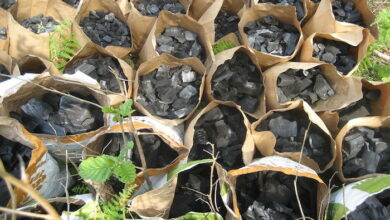
The Soils Cation Exchange Capacity and its Effect on Soil Fertility
Cation exchange capacity.
Soil nutrients exist as positively charged or negatively charged ions when dissolved. The positively charged ions are known as cations and the negatively charged ions are known as anions. The nutrients which exist as cations are calcium (Ca2+), Magnesium Mg2+, ammonium (NH4+), potassium (K+), hydrogen (H+), sodium (Na+) aluminium (Al3+), iron (Fe2+), manganese (Mn2+), zinc (Zn2+) and copper (Cu2+). Some of the nutrients which exist as anions are chloride (Cl-), nitrate (No3-), sulphate (S04)-2 phosphate (H2PO4- and HPO4–), borate (BO3-), and molybdate (MoO4–).
Cation exchange capacity (CEC) is a soil chemical property. It is the ability of the soil to hold or store cations. When soil particles are negatively charged they attract and hold on to cations (positively charged ions) stopping them from being leached down the soil profile. The cations held by the soil particles are called exchangeable cations. On the other hand, negatively charged soil particles repel anions (negatively charged ions). The implication of this is that negatively charged nutrients such as nitrates, sulphate and chlorides are vulnerable to leaching down the soil profile.
The CEC of a soil can be estimated from its colour and texture (as CEC is influenced by organic matter and clay content), or by soil testing. For further discussion on methods of determining CEC please visit https://www.extension.purdue.edu/extmedia). CEC is commonly expressed in meq/100g (milliequivalent per 100g of soil) or cmolc/kg (centimol positive charge per kg of soil). Some key facts to note about cation exchange capacity are listed below.
• As CEC measures a soils ability to hold nutrients it is a key determinant of soil fertility. Soils with high CEC have the ability to hold more cations making them sufficient in calcium, magnesium and other cations. On the contrary, soils with low CEC are easily deficient in cations.
• Soils with high CEC have high ability to hold water (e.g clay soils) while soils with low CEC have low ability to hold water (e.g sandy soils).
• Soils in the low CEC group typically have values <10meq/100g while soils in the high CEC group are greater than 10meq/100g.
• Soils with low CEC become acidic very quickly (for example sandy soils) and would need liming more frequently than soils with high CEC.
Factors influencing the cation exchange capacity of soils
Factors influencing the CEC include the soil type, the soil pH and the soil organic matter content.
Soils are made up of sand, organic matter, silt and clay particles. Soils with high sand content have low holding capacity for cations compared to clayey and silty soils. Clay and silt particles have negatively charged sites which enable them adsorb and hold on to cations. Sandy soils have CEC between 1-5meq/100g.4 Clay soils such as smectite and illite can have CECs between 25-100meq/100g.3,4 Increasing the clay content of a sandy soil will help increase its CEC.
Similar to clay particles, organic matter have negatively charged sites which attract and hold on to cations. They are reported to have CEC as high as 250meq/100g.2,5 The negative charged particles in organic matter are a result of the dissociation of organic acids and this dissociation depends on the soil pH2. This is why when a soil has a high CEC resulting from organic matter content, it is said to be pH dependent. An organic way of increasing a soil CEC is to increase its organic matter content. This method is slow but reliable.

References and further reading
1. David Crouse (2015) Soils and Plant Nutrients Extension Gardener Handbook Retrieved from: https://content.ces.ncsu.edu/extension-gardener-handbook/1-soils-and-plant-nutrients.
2. Agronomic Fact Sheet Series (2007) Cation Exchange Capacity. Retrieved from: https://nmsp.cals.cornell.edu/publications/factsheets/factsheet22.pdf.
3. Rengasamy P, Churchman GJ (1999) Cation Exchange Capacity, Exchangeable Cations and Sodicity. In: Soil Analysis An Interpretation Manual (Eds KI Peverill, LA Sparrow and DJ Reuter). CSIRO, Melbourne.
4. Brown K, and Lemon J (2016) Fact Sheets Cations and Cation Exchange Capacity. Retrieved from: https://www.soilquality.org.au/factsheets/cation-exchange-capacity.
5. Hermite PL, Ott H (1980) Characterization, Treatment and Use of Sewage Sludge: Proceedings of the Second European Symposium held in Vienna, October 21–23. Reidel Publishing Company, Holland.













That is of interest for Merick Januzaj , Balozi Kennedy Okoth, Collins Awandu, Vincent Agidho, Vincent Odolla, Leah Bosibori, Vero Nyaboke, Raphael Onyango, Ratwar Okoth…
Useful? Marcel van Rooijen
That’s why you should walk bare foot every day to absorb negative charge particles that will help with your free radicals……….
please send me any info on soil science
what type of information you need for soil science
That are the sources of these cation to the soil?
Any 3 microorganisms importance on soil